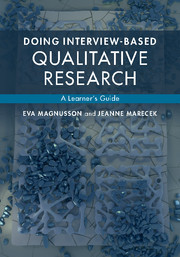Book contents
- Frontmatter
- Contents
- 1 Introduction
- 2 Some examples of interpretative research
- 3 Planning and beginning an interpretative research project
- 4 Making decisions about participants
- 5 Designing the interview guide
- 6 Doing the interview
- 7 Preparing for analysis
- 8 Finding meanings in people's talk
- 9 Analyzing stories in interviews
- 10 Analyzing talk-as-action
- 11 Analyzing for implicit cultural meanings
- 12 Reporting your project
- Epilogue
- References
- Index
7 - Preparing for analysis
Published online by Cambridge University Press: 05 October 2015
- Frontmatter
- Contents
- 1 Introduction
- 2 Some examples of interpretative research
- 3 Planning and beginning an interpretative research project
- 4 Making decisions about participants
- 5 Designing the interview guide
- 6 Doing the interview
- 7 Preparing for analysis
- 8 Finding meanings in people's talk
- 9 Analyzing stories in interviews
- 10 Analyzing talk-as-action
- 11 Analyzing for implicit cultural meanings
- 12 Reporting your project
- Epilogue
- References
- Index
Summary
Up to this point in the research process, the researcher's main tasks have been to plan the project, construct researchable questions, keep notes in the research journal, and do interviews. We now move toward the next phase: doing the analyses. Before you enter the analysis phase, there are several steps you need to take. You need to transcribe your interview material. You also need to consider what to do in order to ensure that your project will meet high standards of quality. You also need to orient yourself to the possible frameworks and procedures for analysis of interview material. We discuss these things in this chapter, turning first to transcription.
Transcribing your interviews
The analyses in interpretative research involve close work with people's words. To do this work, neither listening to an interview recording nor working from notes is sufficient. You must work with a written transcription that is a verbatim (i.e., word-for-word) record of what was said. Transcribing interviews is arduous and time-consuming. You listen to a small segment of talk (often just a phrase or two or a part of a sentence), then stop the playback device, and type what you have heard. You should keep the segments that you play short, otherwise you will either miss words or inadvertently add your own words to what you have heard. Because people often do not speak clearly, you are likely to have to listen to some segments more than once in order to be sure that you have heard and recorded correctly. Transcribing semi-structured interviews is a slow process. It may take between three and five hours to transcribe an hour of talk; depending on the level of detail that you want to capture in the transcription, it may take even longer. You need to plan your time accordingly.
When to transcribe
If at all possible, you should transcribe each interview right after you complete it. At that point, you will still remember what happened in the interview and may be able to complement the spoken words with notes about body language, tone of voice, and so on, as well as with your own reflections during the interview. Furthermore, if you transcribe an interview soon after you have conducted it, you may find it easier to recontact a participant if you find that some critical element is missing or is unclear.
- Type
- Chapter
- Information
- Doing Interview-based Qualitative ResearchA Learner's Guide, pp. 73 - 82Publisher: Cambridge University PressPrint publication year: 2015
- 1
- Cited by



